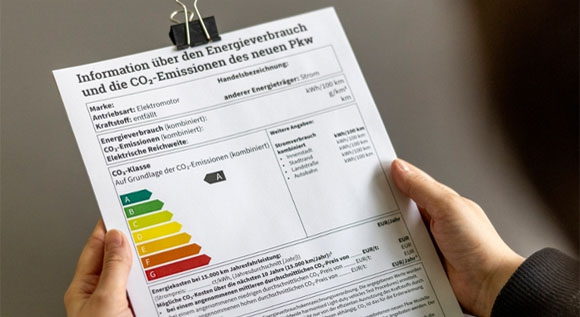Better information to help with buying a new car
In future, a new car label will provide even more comprehensive information about the vehicle’s fuel consumption and carbon emissions. The labelling requirement follows an amendment of the Ordinance on Energy Consumption Labelling for Passenger Cars (Pkw-EnVKV) which came into force at the end of February.
 © dena/Silke_Reents
© dena/Silke_Reents
Dealers and manufacturers must now provide consumers with more comprehensive information on the energy consumption and emission values of new vehicles. New features include information for four different driving modes: city centre, outskirts, country road and motorway.
In future, the new car label will be based on values determined through a more realistic test procedure, the Worldwide Harmonised Light-Duty Vehicles Test Procedure (WLTP). Vehicles will be assigned to different carbon emission classes based on their absolute carbon emissions. The new classification prevents larger and heavier cars from being put in a better carbon emissions class based on their weight than significantly lighter vehicles with the same level of emissions. The car label also points up possible CO2 costs for the next ten years. Rising CO2 costs will have a major impact on the cost of operating a combustion-engine vehicle. The new car label now enables car buyers to choose the most efficient vehicles possible. This not only helps combat climate change, but also makes driving easier on the pocket. Vehicles with higher energy efficiency play a key role in implementing the energy transition in transport thanks to their sustainable solutions and lower emissions.
Car label on all new vehicles and in online vehicle configurators from 1 May 2024
The new label indicating fuel consumption and emissions must be displayed directly on new vehicles and in online vehicle configurators from 1 May 2024 at the latest. Comparisons are also to be made easier through notices displayed at points of sale and a digital guide providing relevant information on all car models on sale in Germany. In addition, it will be mandatory for certain information to be included in print and digital advertising.
For each type of drive, a different label will be displayed. Labelling on electric cars (BEV) and plug-in hybrid vehicles (PHEV) will also include information on electricity consumption and electric range. PHEVs have a combined drive comprised of a combustion engine and an electric engine and will therefore be given double labelling for their carbon emission classes. This will not only show carbon emission class for mixed operation, but also the class for driving when the battery is empty (i.e. in combustion engine mode). Both pieces of information are relevant for helping the consumer make the right purchase decision.
Further information
- Press release by the Federal Ministry for Economic Affairs and Climate Action: New car label coming soon (in German only)
- More information on the car label is available on a dedicated information website provided by the German Energy Agency (dena) (in German only)
- Article by the Federal Ministry for Economic Affairs and Climate Action: Automotives industry (in German only)

